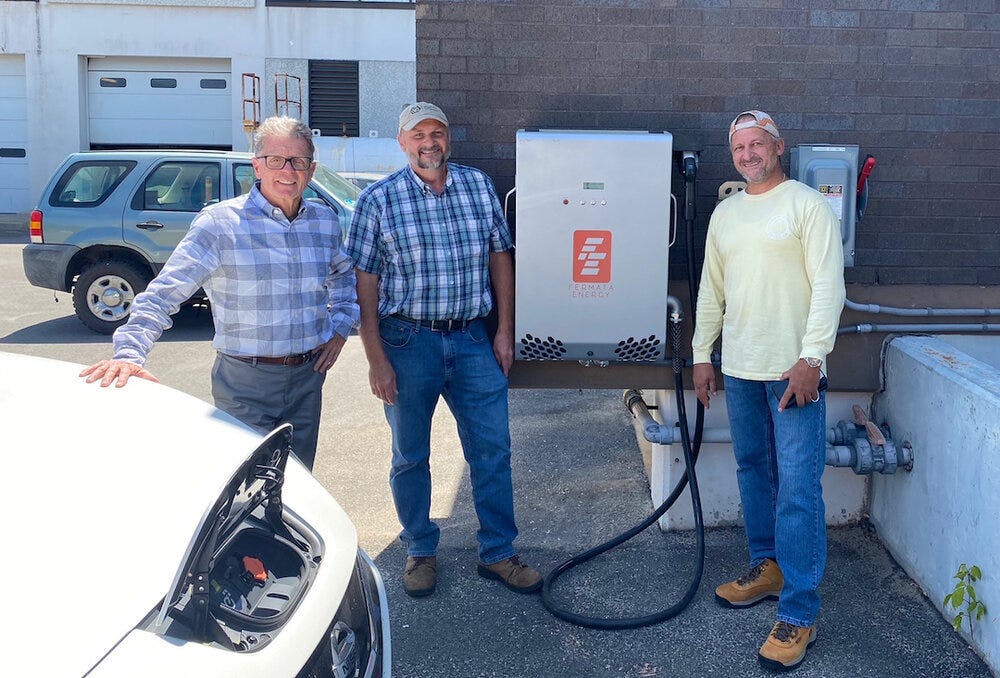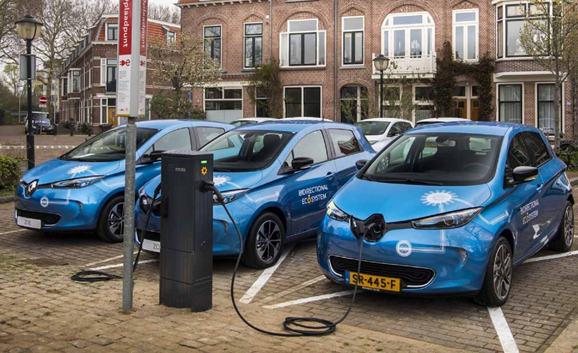
Key takeaways
V2G-enabled vehicles could provide value to power grids by firming renewable energy generation and providing peak demand shaving.
Despite the technical feasibility demonstrated by V2G pilot projects, a market mechanism between EV owners and electric utilities has yet to be established commercially.
Passenger EV adoption of V2G faces obstacles due to scalability issues and lack of clarity around return on investment and impact on battery life.
Utilities have struggled to calculate the value of V2G, obtain regulatory approvals to implement payment mechanisms for V2G services, and adequately incentivize EV owners for the services.
Solving these issues will require a new approach that considers both buyers and sellers from the perspective of market formation.
We recommend that utilities take initiative by funding the equipment necessary for V2G programs and by creating clear, simple programs with strong incentives for customer participation.
We believe that utility commissions should allow utilities to reflect the highly variable value of locational capacity through differentiated pricing.
Given the commercialization challenges for privately-owned EVs in the near term, we believe the path to widespread V2G adoption in the near term is through fleets, not private vehicles.
Background
Vehicle-to-Grid (V2G) or vehicle-grid-integration (VGI) is when electric vehicles return electricity to the grid through bidirectional charging or throttling their charging rate. The product being bought or sold in V2G systems is locational energy capacity: a specific amount of power discharged or abated during a specific time at a specific location. V2G-enabled vehicles could provide value to power grids by firming renewable energy generation and providing peak demand shaving.

V2G is a technology without a market
Since the conception of V2G in 1997, numerous pilot projects have attempted to prove the technology’s commercial viability. Recently, several automotive OEMs have launched or announced V2G-capable EVs, but only two models are commercially available: the Nissan Leaf and the Ford F-150 Lightning. Hyundai, Lucid, Volkswagen, GM, and Volvo are also throwing their hats in the V2G ring with announcements of forthcoming V2G-capable vehicles.
At the same time, utilities and energy providers are piloting V2G schemes to determine the value of EVs as grid resources and how to compensate EV owners. In 2022, Octopus EV deployed a V2G project involving 135 residential EV users and a consortium of energy and utility companies in London. Meanwhile, Eaton is launching a microgrid pilot trailing V2G applications in Vaud, Switzerland, involving 250 charging stations in a commercial and industrial park supporting a solar PV array. SCALE is a 3-year project that kicked off in June 2022 involving leading European cities, universities, and energy and EV companies to test and validate a variety of smart charging and V2L, V2G, and V2H solutions and services in Norway, Netherlands, France, Germany, Hungary, and Sweden. Finally, Duke Energy and Ford Motor Company are partnering on a V2G pilot to be launched in 2023 in North Carolina to enroll up to 100 customers to lease Ford F-150 Lightnings at a reduced price.
Despite the technical feasibility demonstrated by these pilot projects (and dozens that have come before them), a market mechanism between EV owners and electric utilities has yet to be established commercially. Utilities have struggled to determine the value of EVs to the grid, how to capture that value, and how to incentivize EV owners to provide that value.

EV owners are not adequately incentivized to provide V2G services
We believe passenger EV adoption of V2G faces obstacles due to scalability issues and lack of clarity around return on investment and impact on battery life. While V2G could provide a revenue stream for EV owners, EV owners view V2G as a risk that requires capital investment without a clear return.
V2G will require widespread installation of standardized equipment on vehicles and installation of bidirectional chargers at homes. V2G-capable chargers are typically more expensive than traditional chargers, and the costs of other required hardware and electronic components (e.g., a power converter, control/monitoring mechanism, circuit upgrades, etc.) and the cost of installation vary widely with no uniform figures available. Incentivizing consumers and OEMs to shoulder these upfront costs could be a challenge without a clear understanding of the revenue opportunity.
The revenue opportunity for EV owners to sell power back to the grid varies widely between utilities and even across hours of the day and times of the year.
Additional barriers include a lack of clarity and flexibility regarding when the batteries will be discharged onto the grid, when charging time and speed will be impacted, and how battery health could be degraded. V2G programs often require commitments from EV owners to plug in for certain hours of the day, which reduces flexibility in using the vehicle for transportation. This is a key roadblock for EV owners, who typically want to be able to use their vehicle when they need it. In addition, EV owners have indicated a perceived risk of V2G negatively impacting battery health. Although evidence suggests that the impact on battery life from V2G is negligible, EV owners may not understand the technical details, and many have concerns that V2G may harm their batteries. Adding to these concerns, we note that discharging to the grid can void warranties for many EV makes & models.

Utilities have struggled to create a market for V2G services
Utilities have struggled to calculate the value of V2G, obtain regulatory approvals to implement payment mechanisms for V2G services, and adequately incentivize EV owners for the services.
Utilities face challenges in determining what V2G services are worth and clearly communicating that value with customers. To identify the amount that the utility is willing to pay, the utility must determine the amount of capacity that is needed, the optimal time for that energy to be discharged, and the optimal location for that capacity (locational capacity). The value of capacity can vary widely within very short distances (e.g., between two city blocks) because of the hyper-local nature of distribution feeders and circuits. These calculations are quite complex to conduct at scale and are further complicated by dynamically changing load requirements due to EV adoption. In addition, ensuring a vehicle is where it needs to be at the right time can be challenging due to the inherently mobile nature of vehicles (particularly passenger vehicles).
Upgrading to the right hardware and software can be a complex and odious process. Most residential and commercial customer locations do not support bi-directional energy flow. Customer service must be upgraded to allow bidirectional flow. In addition, successful V2G will require smart meters that can measure bidirectional electrical flows and send information back to the grid, and a software architecture to manage charging and recharging cycles. Procuring and installing/integrating the required inverters, meters and software create friction for V2G adoption. Finally, utilities must determine the specific standards (e.g., UL or SAE numbered standards) that bidirectional chargers and inverters must comply with at the EV owner location.
Regulatory requirements can jeopardize the viability of V2G. In most of North America, regulated utilities must seek approval for V2G remuneration procedures from public utility commissions. In most cases, public utility commissions require that all participants in the V2G program, regardless of location, are offered the same remuneration due to equity concerns. However, due to the hyper-local nature of the product, the value that the utility ascribes to the capacity from V2G will be different — perhaps vastly — at different locations. Blanket remuneration amounts for all participants significantly weaken V2G economics for utilities, potentially even jeopardizing the viability of the market.

A market-centric approach is required to solve these challenges
Given the nascent nature of the V2G market and customer acceptance challenges, V2G adoption requires a new approach that considers both buyers and sellers from the perspective of market formation. In this case, the EV owner is the seller of V2G services, enabled by EV and hardware OEMs. The buyers are utilities, enabled by public utility commissions.
Incentivizing utilities to adopt V2G will require regulators and policymakers to recognize the location-specificity of V2G. Capacity is most valuable at the local level, and utilities should be empowered to price differentially based on where they need the storage. We note that this approach may conflict with other stated goals of regulators, such as equity.
V2G hardware providers, such as charging equipment providers and automakers, should seek to partner closely with utilities in specific local markets. Markets most attractive for V2G could include those with a high concentration of EVs or a high reliance on renewable energy. V2G providers should seek to partner with the utilities in these markets to launch pilot projects.
Incentivizing end-consumers to enter V2G programs will require a thoughtful approach. Numerous academic consumer surveys have identified specific ways to promote adoption, such as paying for and installing equipment, reducing plug-in time requirements, limiting discharge cycles, providing attractive monthly remunerations, guaranteeing minimum battery charge levels, and allowing customers to opt out of programs.
Utilities should pay for and install the equipment on behalf of the customer. This approach addresses major barriers to adoption, such as high upfront cost, particularly for low to medium-income customers, as well as complexity surrounding implementation and equipment selection. Utilities should also create clear, simple programs with strong incentives for participation.
Limiting plug-in times and discharge cycles help address customer concerns around flexibility and battery degradation. Notably, the additional plug-in time has a non-linear impact, as the degree of dislike becomes more intense with the increase of the plug-in time. A higher number of discharging cycles has a strong negative effect on the preference for V2G, as it is interpreted by the consumer as causing battery degradation.
Fixed monthly payments have a significant impact. The higher the fixed payments, the more likely EV drivers will participate in V2G contracts. Surprisingly, adding additional payments over the fixed amount has a limited impact; EV drivers are unwilling to extend plug-in times even when compensated.
Guaranteed minimum battery levels have a very strong and positive impact. EV drivers prefer a high guaranteed battery level to alleviate range anxiety and indicated stress from the uncertainty about the real-time state of charge of the EV and fatigue from continuously planning their trips around V2G.
Finally, many consumers are only willing to participate in V2G if they can set parameters on V2G or opt-out of the V2G contract when they perceive that their freedom has been significantly restricted.

V2G providers should focus on fleets
Given the commercialization challenges for privately-owned EVs in the near term, we believe the path to widespread V2G adoption in the near term is through fleets, not private vehicles.
Fleet managers are well-positioned to maximize return on investment and drive V2G adoption at scale, as they can effectively assess impacts on revenue and total cost of ownership. Relative to individual owners, Fleet managers have access to many more EVs, and thereby much more locational capacity, and can make deployments at a reasonable scale. Fleets can make specific agreements with utilities for revenue. Most importantly, fleets are better positioned than consumers to judge return on investment and make informed decisions on whether to adopt V2G.
Relative to passenger vehicles, many fleet duty cycles are amenable to V2G. Many fleets, such as delivery and bus fleets, operate on regular schedules with dedicated uptime and downtime. As a result, their operations would not be disrupted by V2G. This paradigm aligns with the needs of utilities to have vehicles plugged in at certain hours of the day or at certain times.
Conclusion
To date, the V2G market has suffered from a lack of coherent execution and business models. A strategy of focusing on fleets and empowering utilities to make upfront investments for customers and properly compensate locational capacity represents a clear path forward that could ultimately kickstart widespread adoption of V2G.
About the authors
Asad Hussain is the Partner of Research at MIP. Asad previously led PitchBook’s research coverage of the mobility sector, and his research has been featured in several premier media outlets.
Cassidy Shell is a Senior Associate of Strategy & Research at MIP. Cassidy was previously a Senior Associate at the Cleantech Group, where she focused on mobility and sustainability research.
Shweta (Shay) Natarajan is the Partner of Strategy at MIP. Shay has previously held strategy leadership roles at Caterpillar, McKinsey & Co., and Apple.
All authors have equal contributions and are listed alphabetically by first name.
MIP is a collaborative strategic investment firm that brings together the leading stakeholders in the mobility ecosystem — auto companies, parts suppliers, energy companies, fleet operators, logistics providers, technology and communications companies, financial and insurance companies, as well as cities and municipalities — to identify common challenges, find solutions, invest in those solutions, and then scale those innovations across the market.
Sources
PG&E, UKRI, Green Car Congress, Energy Storage News, Equigy, Ford, North Sea Region, Travel Behavior and Society, NREL, UC Berkeley, Top Charger, Energies





